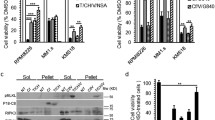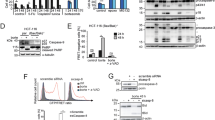Abstract
The proteasome inhibitors are a new class of antitumor agents. These inhibitors cause the accumulation of many proteins in the cell with the induction of apoptosis including TRAIL death receptors DR4 and DR5, but the role of the TRAIL apoptotic pathway in proteasome inhibitor cytotoxicity is unknown. Herein, we have demonstrated that the induction of apoptosis by the proteasome inhibitors, MG-132 and PS-341 (bortezomib, Velcade), in primary CLL cells and the Burkitt lymphoma cell line, BJAB, is associated with up-regulation of TRAIL and its death receptors, DR4 and DR5. In addition, FLICE-like inhibitory protein (c-FLIP) protein is decreased. MG-132 treatment increases binding of DR5 to the adaptor protein FADD, and causes caspase-8 activation and cleavage of pro-apoptotic BID. Moreover, DR4:Fc or blockage of DR4 and DR5 expression using RNA interference, which prevents TRAIL apoptotic signaling, blocks proteasome inhibitor induced apoptosis. MG-132 also increases apoptosis and DR5 expression in normal B-cells. However, when the proteasome inhibitors are combined with TRAIL or TRAIL receptor activating antibodies the amount of apoptosis is increased in CLL cells but not in normal B cells. Thus, activation of the TRAIL apoptotic pathway contributes to proteasome inhibitor induced apoptosis in CLL cells.
Similar content being viewed by others
References
Adams J (2004) The development of proteasome inhibitors as anticancer drugs. Cancer Cell 5(5):417–421
Almond JB, Cohen GM (2002) The proteasome: A novel target for cancer chemotherapy. Leukemia 16(4):433–443
Voorhees PM, Dees EC, O’Neil B, Orlowski RZ (2003) The proteasome as a target for cancer therapy. Clin Cancer Res 9(17):6316–6325
Richardson PG, Barlogie B, Berenson J, Singhal S, Jagannath S, Irwin D, et al (2003) A phase 2 study of bortezomib in relapsed, refractory myeloma. N Engl J Med 348(26):2609–2617
Dou QP, Goldfarb RH (2002) Bortezomib (millennium pharmaceuticals). IDrugs 5(8):828–834
Naujokat C, Sezer O, Zinke H, Leclere A, Hauptmann S, Possinger K (2000) Proteasome inhibitors induced caspase-dependent apoptosis and accumulation of p21WAF1(Cip1 in human immature leukemic cells. Eur J Haematol 65(4):221–236
Pham LV, Tamayo AT, Yoshimura LC, Lo P, Ford RJ (2003) Inhibition of constitutive NF-kappa B activation in mantle cell lymphoma B cells leads to induction of cell cycle arrest and apoptosis. J Immunol 171(1):88–95
Wagenknecht B, Hermisson M, Eitel K, Weller M (1999) Proteasome inhibitors induce p53/p21-independent apoptosis in human glioma cells. Cell Physiol Biochem 9(3):117–125
Williams SA, McConkey DJ (2003) The proteasome inhibitor bortezomib stabilizes a novel active form of p53 in human LNCaP-Pro5 prostate cancer cells. Cancer Res 63(21):7338–7344
Yu C, Rahmani M, Dent P, Grant S (2004) The hierarchical relationship between MAPK signaling and ROS generation in human leukemia cells undergoing apoptosis in response to the proteasome inhibitor Bortezomib. Exp Cell Res 295(2):555–566
Dewson G, Snowden RT, Almond JB, Dyer MJ, Cohen GM (2003) Conformational change and mitochondrial translocation of Bax accompany proteasome inhibitor-induced apoptosis of chronic lymphocytic leukemic cells. Oncogene 22(17):2643–2654
Drexler HC (1998) Programmed cell death and the proteasome. Apoptosis 3(1):1–7
Ling YH, Liebes L, Zou Y, Perez-Soler R (2003) Reactive oxygen species generation and mitochondrial dysfunction in the apoptotic response to Bortezomib, a novel proteasome inhibitor, in human H460 non-small cell lung cancer cells. J Biol Chem 278(36):33714–33723. Epub 2003 Jun 23
MacFarlane M, Merrison W, Bratton SB, Cohen GM (2002) Proteasome-mediated degradation of Smac during apoptosis: XIAP promotes Smac ubiquitination in vitro. J Biol Chem 277(39):36611–36616
Qiu JH, Asai A, Chi S, Saito N, Hamada H, Kirino T (2000) Proteasome inhibitors induce cytochrome c-caspase-3-like protease-mediated apoptosis in cultured cortical neurons. J Neurosci 20(1):259–265
Sun XM, Butterworth M, MacFarlane M, Dubiel W, Ciechanover A, Cohen GM (2004) Caspase activation inhibits proteasome function during apoptosis. Mol Cell 14(1):81–93
Yagita H, Takeda K, Hayakawa Y, Smyth MJ, Okumura K (2004) TRAIL and its receptors as targets for cancer therapy. Cancer Sci 95(10):777–783
Kelley SK, Ashkenazi A (2004) Targeting death receptors in cancer with Apo2L/TRAIL. Curr Opin Pharmacol 4(4):333–339
Liabakk NB, Espevik T (2004) Monoclonal antibodies against TRAIL. Vitam Horm 67:65–79
Keane MM, Ettenberg SA, Nau MM, Russell EK, Lipkowitz S (1999) Chemotherapy augments TRAIL-induced apoptosis in breast cell lines. Cancer Res 59(3):734–741
Ohtsuka T, Buchsbaum D, Oliver P, Makhija S, Kimberly R, Zhou T (2003) Synergistic induction of tumor cell apoptosis by death receptor antibody and chemotherapy agent through JNK/p38 and mitochondrial death pathway. Oncogene 22(13):2034–2044
An J, Sun YP, Adams J, Fisher M, Belldegrun A, Rettig MB (2003) Drug interactions between the proteasome inhibitor bortezomib and cytotoxic chemotherapy, tumor necrosis factor (TNF) alpha, and TNF-related apoptosis-inducing ligand in prostate cancer. Clin Cancer Res 9(12):4537–4545
He Q, Huang Y, Sheikh MS (2004) Proteasome inhibitor MG132 upregulates death receptor 5 and cooperates with Apo2L/TRAIL to induce apoptosis in Bax-proficient and -deficient cells. Oncogene 23(14):2554–2558
Johnson TR, Stone K, Nikrad M, Yeh T, Zong WX, Thompson CB, et al (2003) The proteasome inhibitor PS-341 overcomes TRAIL resistance in Bax and caspase 9-negative or Bcl-xL overexpressing cells. Oncogene 22(32):4953–4963
Sayers TJ, Brooks AD, Koh CY, Ma W, Seki N, Raziuddin A, et al (2003) The proteasome inhibitor PS-341 sensitizes neoplastic cells to TRAIL-mediated apoptosis by reducing levels of c-FLIP. Blood 102(1):303–310
Gibson SB, Oyer R, Spalding AC, Anderson SM, Johnson GL (2000) Increased expression of death receptors 4 and 5 synergizes the apoptosis response to combined treatment with etoposide and TRAIL. Mol Cell Biol 20(1):205–212
Johnston JB, Kabore AF, Strutinsky J, Hu X, Paul JT, Kropp DM, et al (2003) Role of the TRAIL/APO2-L death receptors in chlorambucil- and fludarabine-induced apoptosis in chronic lymphocytic leukemia. Oncogene 22(51):8356–8369
Nagane M, Pan G, Weddle JJ, Dixit VM, Cavenee WK, Huang HJ (2000) Increased death receptor 5 expression by chemotherapeutic agents in human gliomas causes synergistic cytotoxicity with tumor necrosis factor-related apoptosis-inducing ligand in vitro and in vivo. Cancer Res 60(4):847–853
Sheikh MS, Burns TF, Huang Y, Wu GS, Amundson S, Brooks KS, et al (1998) p53-dependent and -independent regulation of the death receptor KILLER/DR5 gene expression in response to genotoxic stress and tumor necrosis factor alpha. Cancer Res 58(8):1593–1598
Wu GS, Burns TF, McDonald ER 3rd, Meng RD, Kao G, Muschel R, et al (1999) Induction of the TRAIL receptor KILLER/DR5 in p53-dependent apoptosis but not growth arrest. Oncogene 18(47):6411–6418
Wang S, El-Deiry WS (2003) TRAIL and apoptosis induction by TNF-family death receptors. Oncogene 22(53):8628–8633
Roth W, Reed JC (2004) FLIP protein and TRAIL-induced apoptosis. Vitam Horm 67:189–206.
Kay NE, Hamblin TJ, Jelinek DF, Dewald GW, Byrd JC, Farag S, et al (2002) Chronic lymphocytic leukemia. Hematology (Am Soc Hematol Educ Program) 193–213
Almond JB, Snowden RT, Hunter A, Dinsdale D, Cain K, Cohen GM (2001) Proteasome inhibitor-induced apoptosis of B-chronic lymphocytic leukaemia cells involves cytochrome c release and caspase activation, accompanied by formation of an approximately 700 kDa Apaf-1 containing apoptosome complex. Leukemia 15(9):1388–1397
Chandra J, Niemer I, Gilbreath J, Kliche KO, Andreeff M, Freireich EJ, et al (1998) Proteasome inhibitors induce apoptosis in glucocorticoid-resistant chronic lymphocytic leukemic lymphocytes. Blood 92(11):4220–4229
Kelley TW, Alkan S, Srkalovic G, Hsi ED (2004) Treatment of human chronic lymphocytic leukemia cells with the proteasome inhibitor bortezomib promotes apoptosis. Leuk Res 28(8):845–850
Pahler JC, Ruiz S, Niemer I, Calvert LR, Andreeff M, Keating M, et al (2003) Effects of the proteasome inhibitor, bortezomib, on apoptosis in isolated lymphocytes obtained from patients with chronic lymphocytic leukemia. Clin Cancer Res 9(12):4570–4577
Begleiter A, Verburg L, Ashique A, Lee K, Israels LG, Mowat MR, et al (1995) Comparison of antitumor activities of 2-chlorodeoxyadenosine and 9-beta-arabinosyl-2-fluoroadenine in chronic lymphocytic leukemia and marrow cells in vitro. Leukemia 9(11):1875–1881
Begleiter A, Wang H, Verburg L, Lee K, Israels LG, Mowat MR, et al (1996) In vitro cytotoxicity of 2-chlorodeoxyadenosine and chlorambucil in chronic lymphocytic leukemia. Leukemia 10(12):1959–1965
Wang S, El-Deiry WS (2004) Inducible silencing of KILLER/DR5 in vivo promotes bioluminescent colon tumor xenograft growth and confers resistance to chemotherapeutic agent 5-fluorouracil. Cancer Res 64(18):6666–6672
Bogner C, Schneller F, Hipp S, Ringshausen I, Peschel C, Decker T (2003) Cycling B-CLL cells are highly susceptible to inhibition of the proteasome: Involvement of p27, early D-type cyclins, Bax, and caspase-dependent and -independent pathways. Exp Hematol 31(3):218–225
Jonsson G, Paulie S, Grandien A (2003) High level of cFLIP correlates with resistance to death receptor-induced apoptosis in bladder carcinoma cells. Anticancer Res 23(2B):1213–1218
Yamada H, Tada-Oikawa S, Uchida A, Kawanishi S (1999) TRAIL causes cleavage of bid by caspase-8 and loss of mitochondrial membrane potential resulting in apoptosis in BJAB cells. Biochem Biophys Res Commun 265(1):130–133
Ehrhardt H, Fulda S, Schmid I, Hiscott J, Debatin KM, Jeremias I (2003) TRAIL induced survival and proliferation in cancer cells resistant towards TRAIL-induced apoptosis mediated by NF-kappaB. Oncogene 22(25):3842–3852
MacLaren AP, Chapman RS, Wyllie AH, Watson CJ (2001) p53-dependent apoptosis induced by proteasome inhibition in mammary epithelial cells. Cell Death Differ 8(3):210–218
Nakaso K, Yoshimoto Y, Yano H, Takeshima T, Nakashima K (2004) p53-mediated mitochondrial dysfunction by proteasome inhibition in dopaminergic SH-SY5Y cells. Neurosci Lett 354(3):213–216
Dai Y, Rahmani M, Grant S (2003) Proteasome inhibitors potentiate leukemic cell apoptosis induced by the cyclin-dependent kinase inhibitor flavopiridol through a SAPK/JNK- and NF-kappaB-dependent process. Oncogene 22(46):7108–7122
Delic J, Masdehors P, Omura S, Cosset JM, Dumont J, Binet JL, et al (1998) The proteasome inhibitor lactacystin induces apoptosis and sensitizes chemo- and radioresistant human chronic lymphocytic leukaemia lymphocytes to TNF-alpha-initiated apoptosis. Br J Cancer 77(7):1103–1107
Masdehors P, Omura S, Merle-Beral H, Mentz F, Cosset JM, Dumont J, et al (1999) Increased sensitivity of CLL-derived lymphocytes to apoptotic death activation by the proteasome-specific inhibitor lactacystin. Br J Haematol 105(3):752–757
Shetty S, Gladden JB, Henson ES, Hu X, Villanueva J, Haney N, et al (2002) Tumor necrosis factor-related apoptosis inducing ligand (TRAIL) up-regulates death receptor 5 (DR5) mediated by NFkappaB activation in epithelial derived cell lines. Apoptosis 7(5):413–420
Kreuz S, Siegmund D, Scheurich P, Wajant H (2001) NF-kappaB inducers upregulate cFLIP, a cycloheximide-sensitive inhibitor of death receptor signaling. Mol Cell Biol 21(12):3964–3973
Olsson A, Diaz T, Aguilar-Santelises M, Osterborg A, Celsing F, Jondal M, et al (2001) Sensitization to TRAIL-induced apoptosis and modulation of FLICE-inhibitory protein in B chronic lymphocytic leukemia by actinomycin D. Leukemia 15(12):1868–1877
Luo H, Wu Y, Qi S, Wan X, Chen H, Wu J (2001) A proteasome inhibitor effectively prevents mouse heart allograft rejection. Transplantation 72(2):196–202
Sun K, Welniak LA, Panoskaltsis-Mortari A, O’Shaughnessy MJ, Liu H, Barao I, et al (2004) Inhibition of acute graft-versus-host disease with retention of graft-versus-tumor effects by the proteasome inhibitor bortezomib. Proc Natl Acad Sci USA 101(21):8120–8125
MacFarlane M, Harper N, Snowden RT, Dyer MJ, Barnett GA, Pringle JH, et al (2002) Mechanisms of resistance to TRAIL-induced apoptosis in primary B cell chronic lymphocytic leukaemia. Oncogene 21(44):6809–6818
Author information
Authors and Affiliations
Corresponding author
Rights and permissions
About this article
Cite this article
Kabore, A.F., Sun, J., Hu, X. et al. The TRAIL apoptotic pathway mediates proteasome inhibitor induced apoptosis in primary chronic lymphocytic leukemia cells. Apoptosis 11, 1175–1193 (2006). https://doi.org/10.1007/s10495-006-8048-9
Published:
Issue Date:
DOI: https://doi.org/10.1007/s10495-006-8048-9




